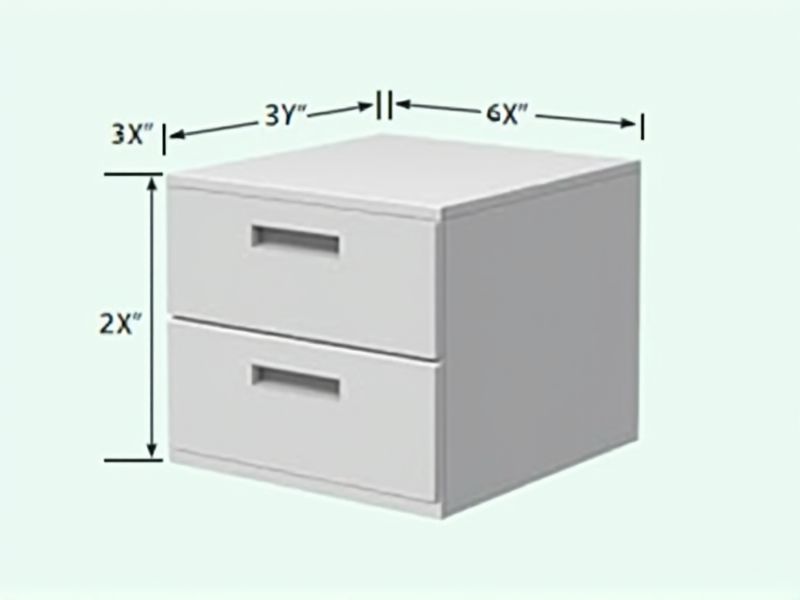
When choosing a filing cabinet, understanding standard dimensions can help you select the right fit for your workspace and storage needs. Typically, vertical filing cabinets come in widths of about 15 to 18 inches, depths of 25 to 28 inches, and heights that vary based on the number of drawers--usually around 29 inches (two drawers) up to 52 inches (four drawers). Lateral filing cabinets offer wider options, commonly 30 to 42 inches wide, 18 to 20 inches deep, and 28 to 53 inches high. Knowing these standard sizes ensures you can plan your office layout efficiently and store documents securely.
Letter Size Drawer
The standard filing cabinet often accommodates Letter size drawers, measuring 8.5 x 11 inches, making it ideal for organizing documents efficiently. Typically, a standard filing cabinet features multiple drawers--commonly ranging from two to five--that allow for optimal document storage and easy access. With a capacity of holding up to several hundred letter-size files, these cabinets enhance workspace organization and improve overall productivity. When selecting a filing cabinet, consider the durability of materials, such as steel or wood, which greatly affect the longevity and structural integrity of your storage solution.
Legal Size Drawer
The standard filing cabinet designed for legal-size drawers typically measures 15 inches in width, 18 inches in depth, and 40 inches in height. These cabinets are built to accommodate documents sized 8.5 by 14 inches, ensuring optimal organization for legal paperwork. Many models feature high-quality steel construction, providing durability and security for your sensitive files. Invest in a filing cabinet with smooth glide drawers and a central locking mechanism to enhance both accessibility and safety for your important documents.
Vertical Filing Cabinet
A vertical filing cabinet offers efficient organization for documents, typically featuring multiple drawers that range from two to five in height. These cabinets usually stand about 25 to 60 inches tall, accommodating letter-sized or legal-sized files with ease. Many models come with locking mechanisms to ensure the security of sensitive information, making them suitable for both home and office environments. When choosing a vertical filing cabinet, consider the material, such as steel or wood, which can affect durability and aesthetic appeal.
Lateral Filing Cabinet
Lateral filing cabinets are designed with horizontal drawers that allow for easy access to documents and maximize office space efficiency. Generally, these cabinets can accommodate legal or letter-sized files, with a height of around 36 to 54 inches and depth options ranging from 18 to 30 inches. With a typical capacity of 3 to 5 drawers, a lateral filing cabinet can hold hundreds of files, supporting organization and retrieval. When selecting your cabinet, look for sturdy construction materials, lock mechanisms for security, and finishes that enhance your workspace aesthetics.
Drawer Depth
When choosing a filing cabinet, the drawer depth is crucial for maximizing storage efficiency. Standard drawer depths typically range from 15 to 20 inches, accommodating various file sizes including letter and legal dimensions. Features such as full extension slides can enhance accessibility, allowing you to easily reach documents stored in the back. Ensuring the correct drawer depth will not only optimize your workspace but also help maintain organization and ease of use.
Cabinet Height
The standard height for filing cabinets typically ranges between 28 to 42 inches, catering to various storage needs and office spaces. A 2-drawer filing cabinet usually stands at around 30 inches, offering accessibility and convenience for everyday use. For larger storage requirements, a 4-drawer cabinet can reach around 52 inches in height, providing ample space for organization. Choosing the right cabinet height can enhance your workflow, ensuring that files are both easily reachable and efficiently stored.
Cabinet Width
A typical filing cabinet width ranges from 15 to 36 inches, accommodating various spaces and storage needs. Standard widths such as 18, 24, and 36 inches are popular choices for both home and office environments, providing ample room for letter or legal-sized files. When selecting a cabinet, consider that a wider model, like a 36-inch cabinet, can hold more drawers, increasing your storage capacity significantly. Your choice will affect not only functionality but also the overall aesthetic of your workspace.
Mobile Filing Cabinet
Mobile filing cabinets are designed for flexibility and efficient space utilization in offices, featuring wheels for easy movement. These units typically come with a height of 28 to 30 inches, allowing them to fit under standard desks. Many models offer various storage capacities, ranging from 2 to 4 drawers, accommodating both letter and legal-sized documents. With a locking mechanism, mobile filing cabinets ensure the security of your sensitive information while providing accessibility when needed.
Fireproof Cabinet
Fireproof filing cabinets provide essential fire protection for your important documents, often rated to withstand temperatures up to 1700degF for a specified duration that can range from 30 minutes to 2 hours. These cabinets are constructed from specialized materials, typically steel, with insulation designed to prevent internal heat buildup and safeguard contents from flames and smoke damage. Features may include locking mechanisms, waterproof designs, and fire-resistant seals, ensuring that your documents remain safe in various conditions. Investing in a fireproof cabinet can significantly reduce the risk of losing critical paperwork due to unexpected fires, making it a valuable addition to your office or home.
Drawer Glide Mechanism
The drawer glide mechanism is a critical component of a filing cabinet, determining the ease of use and durability. High-quality glide mechanisms typically feature ball bearing systems that allow for smooth operation and can support weight capacities ranging from 50 to 100 pounds per drawer, ensuring durability and reliability. Standard filing cabinets may come with varying glide types, such as metal or plastic, with many offering full-extension capabilities that allow access to the entire drawer interior. When selecting a filing cabinet, consider the glide mechanism to enhance your organization and efficiency in managing documents.
